|
|
Post by bixaorellana on Feb 18, 2010 4:43:00 GMT
Yesterday was the day before Lent. I went to the the Ex Marquesado church in Oaxaca because of a slim rumor that there would be carnival activity there. Since I knew the church was near the old train station, I wasn't too disappointed that I'd showed up for a pre-Lent non-event. First I have to get across this big road and around that wall. 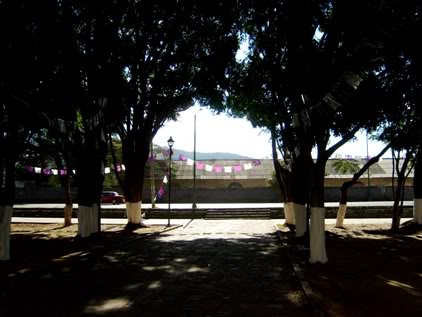 Success! This whole area is now a minimally maintained museum. The train has not been out of operation for all that long. 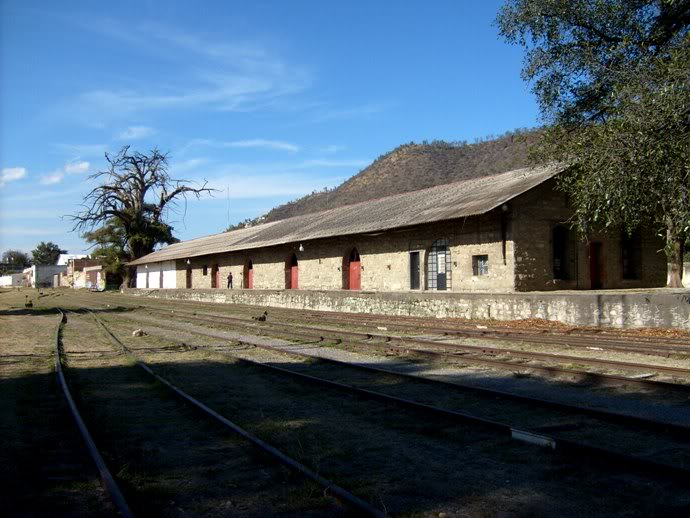 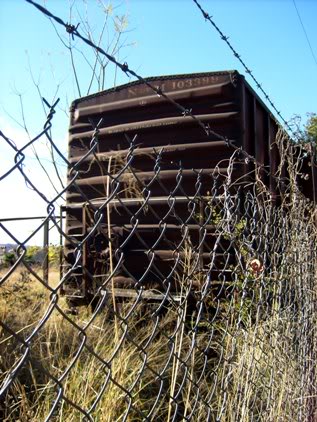 There are bits of mysterious equipment here and there. 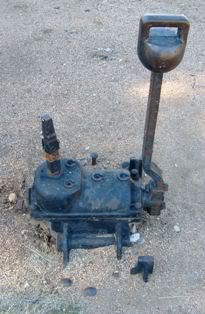 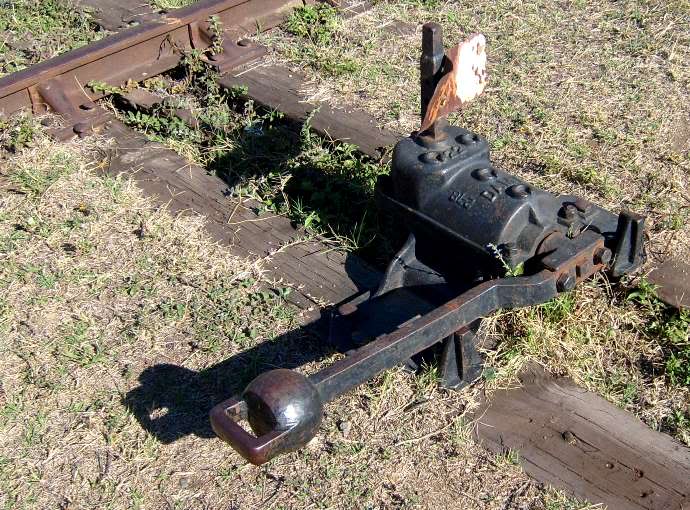 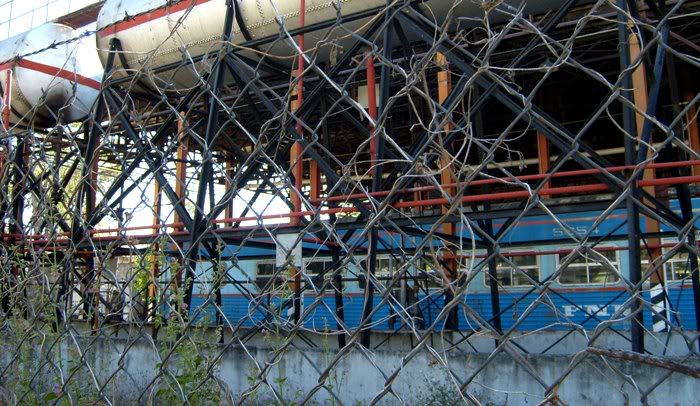 This little building is to the left of the passenger car above. It must have been the pumping station for those big water tanks. 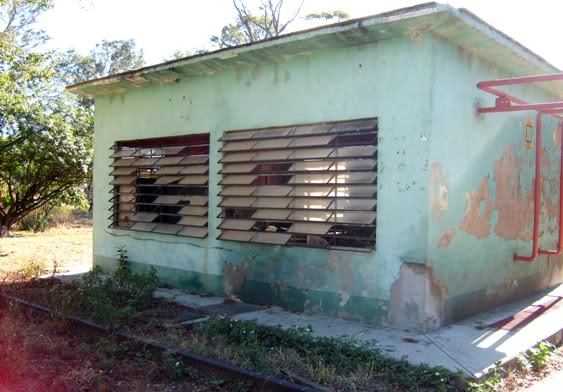 The waiting platform -- 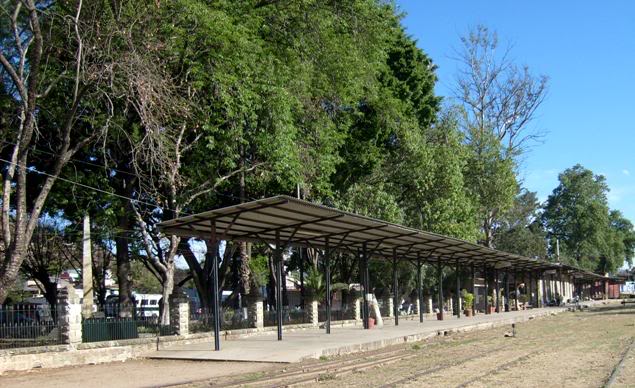 A nod to security, referring to the line painted on the platform floor - "Don't cross the yellow line when the train is in motion". The sign is very high up in the rafters, so not very visible. Note the handsome brick barrel ceiling. 
|
|
|
|
Post by bixaorellana on Feb 18, 2010 4:43:17 GMT
|
|
|
|
Post by Deleted on Feb 18, 2010 6:11:57 GMT
Really excellent photos, and I come from a rail family. Is the line abandoned now or just the station? Is rail travel declining in Mexico?
|
|
|
|
Post by bixaorellana on Feb 18, 2010 7:33:51 GMT
Thanks, Kerouac. The line and the station are both out of use. There are at most two passenger lines left in the whole country -- the one from Monterrey to Mexico City, and the Copper Canyon train, if they're both still running. There are no freight trains running through Oaxaca.
My first trip to Mexico, in the early '70s, was by train. I was young and we didn't know what we were doing, but somehow got from Laredo, Texas to Mérida, with all the leisure, the soaking up of new sights, and the camaraderie that train travel entails. A favorite memory is standing on the platform between cars, clacking along in the dry interior of Mexico, while a conductor rhapsodized about the sea: "People say the sea is blue. It can be blue, but the sea is green, it's orange, it can be purple."
The trains themselves were magnificent. I think some of the cars were old American ones from the 30s, 40s, and 50s, but in great repair. I particularly remember the etched glass panels at the front of the cars and the pleasant dining accomodations (but not good food -- it was "continental"). I also remember an endless night in one of those "Some Like It Hot" berths. Don't know about the ones in the movie, but the one we had did not fit two adults. All night long we took turns getting comfortable enough to sleep, as the train stopped and backed up repeatedly. AT some time in the wee hours, more people boarded in the pitch dark, one of whom stepped on my face as he climbed into his berth.
I knew someone who took the train from Oaxaca to Mexico City in summer of 1997. It took 16 hours. (it was approximately a 6 hour car trip). In the last years of the train here in Oaxaca, cabbies looking for late night fares used to cruise the train station here for the 11 p.m. from Puebla. It wasn't lucrative work, though, because they couldn't charge full fare since train passengers were by definition poorer people.
|
|
|
|
Post by imec on Feb 18, 2010 17:59:09 GMT
Really beautiful images bixa! You been studying composition by any chance??? It sure looks like it.
|
|
|
|
Post by Deleted on Feb 18, 2010 18:08:32 GMT
Don't you want to go back and get some of those boxes?
|
|
|
|
Post by bixaorellana on Feb 18, 2010 18:43:15 GMT
Kind words, Imec -- thanks. Those pictures were taken with the late winter sun afternoon sun beaming onto most of the subject matter and into the lens of my camera. Angling the camera to get what I wanted and to see something besides white glare in the viewfinder was tricky. Kerouac, I did want to open boxes, and felt quite larcenous about those clocks. What rather upset me, though, was the sight of crumbling buildings and disused railway cars in an area where many people live in tin shacks. Sure, very nice to have a museum, but it would have been enlightened to team it with a socially helpful project. A case in point is provided by the link I found after posting the OP. It provides the name of that brick roof vaulting which is fairly common around here, and corroborates my guess about the pump house, but does not explain these buildings, which quite intrigued me:  What drew my attention were the roofs and the general shapes, which aren't common in this area. You can see a little bit of the playground equipment that's part of the museum grounds, then the tracks, and these ruined buildings. Were they built by the railroad for some employees? Why are they abandoned? |
|
|
|
Post by bixaorellana on Feb 19, 2010 21:45:40 GMT
As noted above, I saw things that I could not explain or identify. However, I also saw something that I could identify, but which mystified me greatly.
Does anyone know what it was?
Clue: It is something that really does not belong.
Hint: It can be seen in one of the photographs in Reply #1.
|
|
|
|
Post by hwinpp on Feb 20, 2010 2:07:08 GMT
If train lines are being given up, does that mean people are all traveling by bus? Even if it is more expensive?
Nice pics, was anybody apart from you around?
|
|
|
|
Post by Deleted on Feb 20, 2010 6:04:06 GMT
I'm intrigued by that press thing in the office.
|
|
|
|
Post by bixaorellana on Feb 20, 2010 7:08:25 GMT
I guess so, HW. There is every level of bus travel you can imagine, and some of it is very cheap. I really don't know if there are more bus routes to make up for the lost trains. There were a few other people around, but so few that our paths never crossed. Most of the time, I had the place to myself. Kerouac, there are two press things in two different offices. I am looking at the pictures again & feeling like a jerk. Why didn't I go in and read all the little cards? Maybe I was afraid of getting my hot paws too near those clocks. Maybe I need to go back. It's pretty nice over there. Also, it turns out there is an organic market on the grounds three times a week. So ....... no one is even attempting to answer the question in #6? |
|
|
|
Post by Deleted on Feb 20, 2010 23:09:52 GMT
Yes, what are those damned presses for?
As for the question in #6, I certainly don't know. My grandparents lived on a street of railroad houses for more than 50 years, and those houses are still all occupied (having been sold to the residents at some time in the past). If the Mexican railways built housing for the employees, I can't imagine that the people were evicted and the homes abandoned, but maybe things are organized completely differently in Mexico. I hate to see such places going to waste, as do you.
|
|
|
|
Post by bixaorellana on Feb 21, 2010 4:16:42 GMT
Okay, I guess I can't fuss at the one person who bothered to guess, but you're being all socially responsible and serious and guessing about the wrong thing.
Look at the pictures in Reply #1, please.
There is something odd, very odd in one of them.
|
|
|
|
Post by fumobici on Feb 21, 2010 4:17:32 GMT
No idea on the riddle, it's probably one of the several objects I simply can't identify from the photos. But mostly, very cool photos of a very interesting place. Too bad about the lack of train service in modern Mexico, it's easily the most energy efficient way of hauling freight or passengers from city to city. Maybe Mexico has so much oil it doesn't need to worry about such things.
|
|
|
|
Post by bixaorellana on Feb 21, 2010 4:36:06 GMT
A gas station attendant told me there are no refineries in Mexico, and that's why gasoline isn't cheap. The gasoline in Mexico is refined in the US, then shipped back here.  Mexicans can be very oblique -- a form of politeness that is confusing and frustrating to someone who wants straight information. When I was still living in the US, on the Texas border, I tried to plan a trip into Mexico by train. Accordingly, I went to station in Matamoros and talked to a lady in the office there. First I found out there was no such thing as a schedule. Then she told me that the train took nine hours from Matamoros to Reynosa. That would be a two hour trip by car if you never got out of third gear. Nine hours, I repeated, aghast. Well, it could be longer, she allowed. I thanked her and went in search of the station manager. He politely told me how I could get from A to B, thence to C, etc. When he paused, I said that I was sure I'd misunderstood the office lady about the nine hours. He said, no, sometimes the train had to wait while the rails were repaired, sometimes the train fell off of the rails. "You're saying I shouldn't take the train?" I asked. He nodded, and said that nothing was maintained and the whole system was falling apart. Come on, Fumobici ~ be the first one to spot the out-of-place object. This is child's play! |
|
|
|
Post by fumobici on Feb 21, 2010 4:56:16 GMT
The only thing that jumps out at me is a rather out of place looking large artwork in photo #6.
|
|
|
|
Post by bixaorellana on Feb 21, 2010 5:40:08 GMT
Bingo! Large, yes. Art?work, maybe. This will give you an idea of its size:  Apparently, some turkeys were harmed in the making of this objet d'art.  |
|
|
|
Post by onlymark on Feb 21, 2010 6:36:35 GMT
The presses are printing/copying presses from around the Victorian era. Possible used for timetables or notices.
Commonly known as a Victorian book press.
|
|
|
|
Post by bixaorellana on Feb 21, 2010 7:18:45 GMT
Really?! Thanks, Mark. Maybe that's what made the good old days good here -- there were timetables. It's almost impossible to get a printed timetable. If you want a bus, you generally go to the bus station and stand there adenoidally transfixed by the big timetable overhead. Coincidentally, I took this picture the other day when I was downtown. It's blurred because that mechanism was moving really fast. Wonder what the date on this printing press might be. |
|
|
|
Post by bjd on Feb 21, 2010 7:39:55 GMT
I think it's always a shame when trains are allowed to die and buses take over transportation. It often seems to be a result of a country's not being willing to maintain services or privatization (like in Argentina). The result is more road accidents, pollution, etc.
|
|
|
|
Post by hwinpp on Feb 22, 2010 2:32:59 GMT
Agree with bjd. There are certain things a government has to maintain, train cheap transportation is one of them.
Re the riddle, I thought you might have meant
The big picture/painting on the far side of that room.
|
|
|
|
Post by bixaorellana on Feb 22, 2010 2:48:54 GMT
Yes, and you have to wonder what is the process and the motivation for allowing the train system to die in a country.
That was an okay guess, HW, but I was doing a more "where's Waldo" thing. I wanted to force y'all to really look at the pictures!
|
|
|
|
Post by existentialcrisis on Feb 22, 2010 14:15:51 GMT
Umm Bixa.. I think fumobici was talking about something else.... he made the same guess as i did about the painting in photo 6 ... is that not also strange?
|
|
|
|
Post by bixaorellana on Feb 22, 2010 15:25:10 GMT
 So I gave away the answer to you all without making you strive and suffer more?! Well sure, the painting and other stuff is obviously just stored in that room and has nothing to do with the train museum, thus strange. But I wouldn't have asked everyone to hunt for something that visible.
|
|
|
|
Post by Kimby on Feb 22, 2010 16:16:38 GMT
I think it's always a shame when trains are allowed to die and buses take over transportation. It often seems to be a result of a country's not being willing to maintain services or privatization (like in Argentina). The result is more road accidents, pollution, etc. I think passenger rail service in the US died when gasoline became so cheap and interstate highways so good that everyone could drive where they wanted to. And freight also moves over the highways with relatively inexpensive fuel, further reducing the economy of maintaining a rail system. So railroads went out of business and their rights of way were unfortunately given up or sold. In some places, like Wisconsin, they have preserved the rights of way as bicycle trails which could be re-converted to rails in the future if necessary (but not without angering the bicyclists who love the trail system). In other states, like Montana, the unused railbeds reverted to the underlying land owners, so to reinstate rail service (OR create bicycle paths), right of way would have to be purchased or condemned by eminent domain. Such a shame. |
|
|
|
Post by bixaorellana on Feb 24, 2010 16:30:46 GMT
If you read the Wikipedia article about the history of rail service in the US, it can leave you wanting to know more. en.wikipedia.org/wiki/Rail_transport_in_the_United_States Pretty fascinating, and shocking in many ways. That's interesting about the bike paths, Kimby. Also, re: " In other states, like Montana, the unused railbeds reverted to the underlying land owners...", the Wikipedia article says this: "private enterprise built nearly all the country's railroads, using charters from state government that created the business corporation and gave a limited right of eminent domain, allowing the railroad to buy needed land, even if the owner objected." Who knew?! Here's the Wikipedia article on rail transport in Mexico: en.wikipedia.org/wiki/Rail_transport_in_Mexico It says in part: "The rail system suffered great deterioration from neglect during the period of the Mexican Revolution. Following the Revolution, the entirety of the Mexican rail system was nationalized between 1929 and 1937. In 1987, the government merged its five regional railroads into FNM *. During the later period of national ownership, FNM suffered significant financial difficulties..." "In 1995, the Mexican government announced that the FNM would be privatized and divided into four main systems. As part of the restructuring for privatization, FNM suspended passenger rail service in 1997." [although there were passenger trains after that ~ so,?] *Ferrocarriles Nacionales de México = National Railroad of Mexico |
|
|
|
Post by Kimby on Feb 26, 2010 16:41:28 GMT
If you read the Wikipedia article about the history of rail service in the US, it can leave you wanting to know more. en.wikipedia.org/wiki/Rail_transport_in_the_United_States Pretty fascinating, and shocking in many ways. That's interesting about the bike paths, Kimby. Also, re: " In other states, like Montana, the unused railbeds reverted to the underlying land owners...", the Wikipedia article says this: "private enterprise built nearly all the country's railroads, using charters from state government that created the business corporation and gave a limited right of eminent domain, allowing the railroad to buy needed land, even if the owner objected." Who knew?! Even worse, the land grants made in the 19th century to encourage railroad-building and westward expansion have resulted in a checkerboard ownership with mile square blocks of land owned by the railroads alternating with blocks owned by the government (US Forest Service lands), making present-day management problematic. The grants for the railroad companies were to provide timber for railroad ties. However, when that need no longer existed, the RR companies morphed into timber companies that "liquidated" the valuable trees for sale as lumber. And now that the lumber demand is declining and mills are failing, the timber companies have morphed again into Real Estate sales companies, garnering favorable tax status and liquidating the land itself. The US government unintentionally gave up about half of the land in some areas to encourage railroads and ended up encouraging obscene profits and proliferating subdivisions of mini-ranches and McMansions. (sorry if this is a threadjack) |
|
|
|
Post by bixaorellana on Mar 8, 2010 16:57:01 GMT
It's hardly a threadjack, Kimby, since it charts the arc of greed and how it hurt some and helped others. I don't know that the US gov't "unintentionally" did anything. I'm sure then, as now, they were happily in bed with those who profited by the land grab. Here's a bit of serendipity -- as I searched (in vain, so far) to find the exact elements involved in the downfall of RR passenger service in Mexico, I found this news article, posted just one hour ago: Kansas City Southern Acquires Puerta Mexico Intermodal Facility, Adds Direct Train Service <--- click |
|
|
|
Post by bixaorellana on Apr 26, 2010 1:25:12 GMT
Today a friend and I went to the supposed organic market held on the grounds of the old railway station. There were no stands selling produce, although quite a few selling food. We got some things from a delightful Italian baker (who also had Korean treats), strolled around, then sat and had coffee. No pics because I was so relaxed I forgot. Besides, you all know how tables setting out under trees look. As we meandered out, I poked my head in a couple of rooms I didn't go into on my last visit. There I found an exhibition of (bad) paintings and some displays of rail stuff such as this: 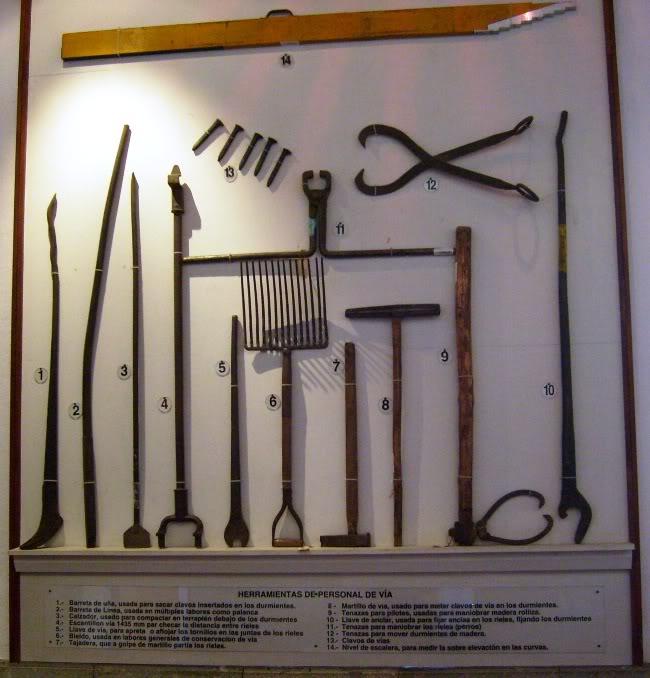  But this was the real thrill. It was impossible to get a good shot with no glare, but I cropped and fixed a couple of areas & it's like looking through a window back in time. 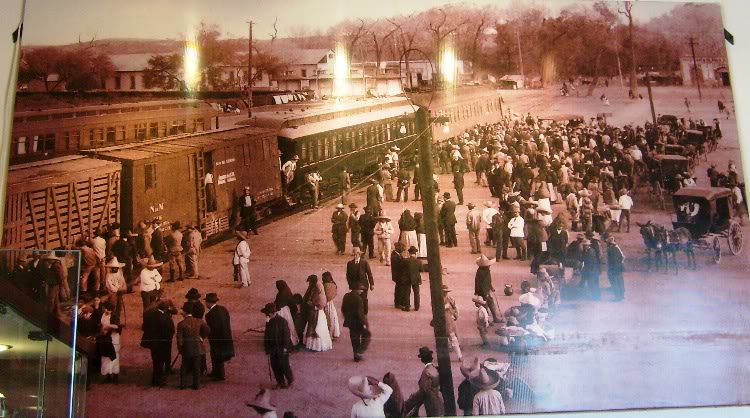 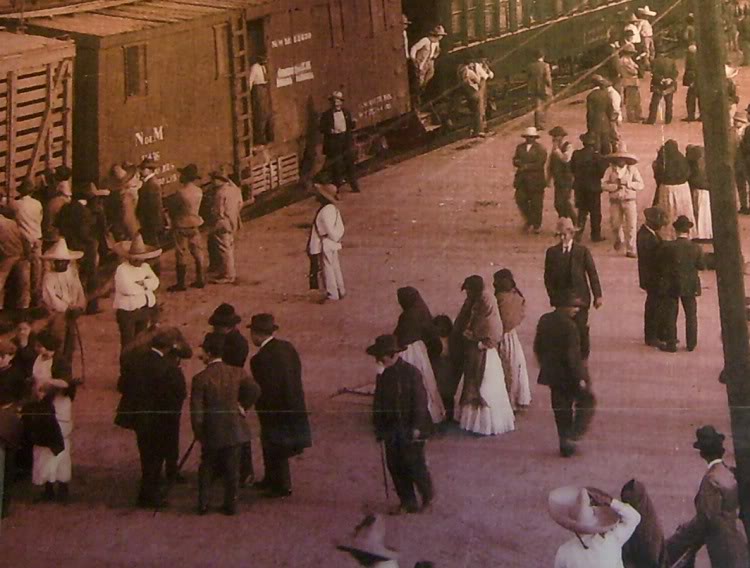 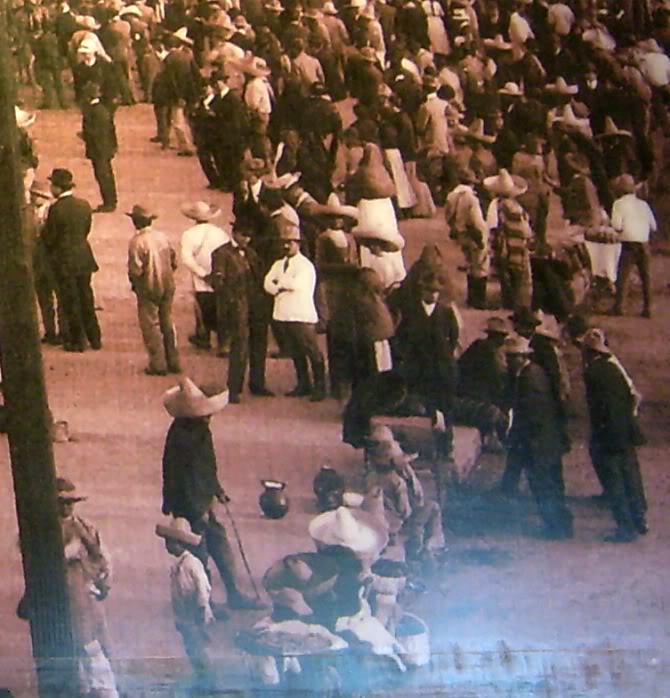 Some many wonderful vignettes and groupings. Can you look at this picture, for instance, and not think "impressionist painting"? 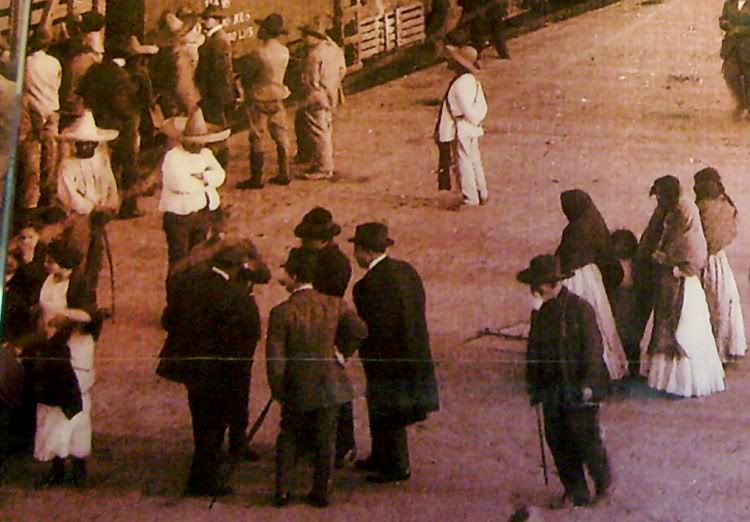 |
|
|
|
Post by Deleted on Apr 27, 2010 5:19:08 GMT
My main reaction is surprise that Mexicans really did use to wear sombreros! (sort of like some of the French used to wear berets, but memory blocks it out)
|
|